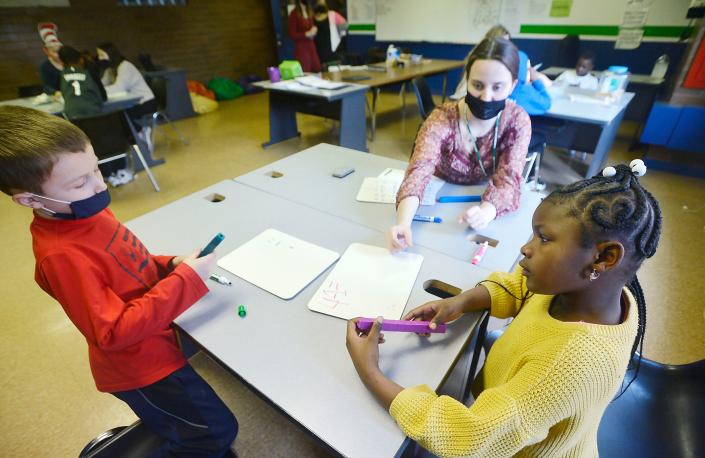4.45% tax hike proposed to retain Erie School District programs added during pandemic
[ad_1]
Using millions of dollars in federal pandemic-relief funds, the Erie School District since mid-2020 has launched a number of initiatives and programs to help students who faltered during the COVID-19 outbreak.
Erie schools Superintendent Brian Polito wants to keep those added supports after the pandemic-related aid runs out on Sept. 30, 2024.
Retaining the supports, however, means raising taxes — by as much as 4.45% a year through 2027-28.
At Polito’s recommendation, the Erie School Board has agreed to include a 4.45% tax increase in the Erie School District’s preliminary 2022-23 budget. Much of the additional revenue would go toward maintaining funding for the pandemic-era programs and initiatives, designed to address “learning loss” due to the lack of in-person instruction during much of the COVID-19 outbreak.
The new offerings include the district’s after-school programs at the city’s community centers and other locations; the district’s summer school program; and the district’s hiring of more mental health specialists and teachers, with the added teachers reducing class sizes to foster learning.
Added supports:Erie’s neighborhood centers playing crucial role during pandemic
The district is paying for the supports using money from the federal government’s Elementary and Secondary School Emergency Relief Fund, known as ESSER, created in April 2020, during the early days of the pandemic.
The total ESSER Fund allocation for the Erie School District is $97.6 million. The federal government granted the district $6.8 million via the Coronavirus Aid, Relief and Economic Security Act, in April 2020; $30 million via the Coronavirus Response and Relief Supplemental Appropriations Act, in December 2020; and $60.8 million via the American Rescue Plan, in March 2021.

The Erie School District has used the bulk up of the money on capital improvements, technology and other one-time expenses. The money has gone to computers for students learning online, upgrades to ventilation systems throughout the district’s 16 school buildings, large-scale building improvements at Erie High School and Northwest Pennsylvania Collegiate Academy and security improvements at the middle and high schools in response to the April 5 shooting at Erie High School.
Massive revamp:Erie High will undergo more renovations after bids come in $10 million lower than expected
The district also appropriated millions of other ESSER dollars for the student-based programs and initiatives.
The district would have to spend $9.3 million of its own money to keep those supports fully funded starting in 2024-25, the district’s first academic year without ESSER allocations, according to district records. The $9.3 million represents the current cost of the ESSER-funded programs adjusted for inflation for 2024-25, according to the district.
ESSER funding:‘It’s about looking forward’: How Erie County schools might spend $100M+ in stimulus funds
The district for years has focused on addressing low academic performance among many of its more than 10,000 students, of which 72% are classified as “economically disadvantaged,” according to state data. Continuation of the ESSER-funded programs would provide additional resources for students to meet academic goals.
“We would like to keep some if not all of the ESSER-funded initiatives after that funding runs out,” Polito said. “We need to start planning now and start building our budget up to make sure that is sustainable.”
Polito commented on Wednesday, at the Erie School Board’s monthly nonvoting committee-of-the-whole study session. The board consented to adding the 4.45% increase to the district’s $250 million preliminary budget for 2022-23. The board will vote on approving the preliminary budget at its monthly voting meeting this coming Wednesday.
The board and district administration will then review the preliminary budget ahead of a vote on the final budget in June. The board must pass a final budget by June 30 so it will be effective July 1, the start of the district’s 2022-23 fiscal year.
Polito said the proposed tax increase could drop depending on how much additional funding the district gets from the state in 2022-23 for basic education and special education. The state budget is also effective July 1. Polito also said he will develop a report for the School Board that prioritizes the ESSER-funded programs his administration would like to retain.
“That will give the board flexibility as we continue to have discussions in May and June,” Polito said in an interview.
Tax increase’s effect on homeowners
A tax increase of 4.45% would raise about $2.3 million in additional revenue in 2022-23. A 4.45% increase would raise school taxes by $78.85 for the owner of a home assessed at $100,000, according to district records.
The current school tax bill for the owner of a home assessed at $100,000 in Erie is $1,772, according to Erie County assessment records. The figure drops to $1,428 if the homeowner receives a $344 reduction due to a homestead exemption, which provides relief from school property taxes.
The state gives homestead exemption reductions using gaming revenue. Homeowners must apply for the exemptions for their primary residences.
Even if the School Board declines to raise taxes by 4.45%, Polito said he would still like an increase of at least 2.46%. That is the minimum annual percentage tax increase recommended in the district’s state-mandated financial improvement plan, adopted in 2019. The school district must follow the plan in exchange for its receipt, starting in 2018, of $14 million in additional state aid each year to stay solvent.
Citing the school district’s financial stability, Polito in November petitioned the state Department of Education to release the district from the financial improvement plan. The request is pending.
Request sent to state:Erie School District aims for new era, asks state to end financial oversight, citing stability
The School Board since the adoption of the plan has raised taxes 2.46% in the 2019-20 budget and 3% in the 2021-22 budget, with no increase in the 2020-21 budget after Polito and the board decided to hold off on a hike due to the pandemic. An increase of 2.46% would raise an additional $1.3 million in revenue and increases taxes by $43.59 for the owner of a home assessed at $100,000, according to district figures.
Help from homestead exemption
The increase in the homestead exemption reduction would help offset any tax increase, Polito said. He said a boost in gaming revenue at casinos, plus the addition of online sports betting in Pennsylvania, is driving up the reduction by $89 in 2022-23, from $344 to $433 per homeowner, no matter what the assessed value.
The state Department of Education has set the 2022-23 homestead exemption at $433 for the Erie School District, according to department records.
Spending and security:Next areas to get security upgrades at Erie High, other schools? The restrooms
As Polito told the School Board, the owner of a home assessed at $100,000 would still come out $10 ahead with a 4.45% tax increase. Though the increase would cost the homeowner $78.85, the increased homestead exemption would reduce the owner’s taxes by $89.

“Even with that 4.45% increase, those taxpayers will see a $10 reduction in real estate taxes,” Polito said.
The offset would be higher for homes assessed at less than $100,000, but the offset would be lower for homes assessed at more than $100,000.
Avoiding another financial crisis
Fueled by the $14 million in additional state aid, the Erie School District has stabilized its finances after years of teetering toward insolvency. The district is projected to end 2021-22, on June 30, with a fund balance, or reserve account, of $30.5 million, and the district is projecting a fund balance of $29 million in 2022-23, without a tax increase, according to district estimates.
But as the financial improvement plan highlights — and as Polito, a certified public accountant and the school district’s former chief financial officer, has emphasized — the district risks eroding its reserves if it fails to use tax increases to keep pace with rising costs, such as pay increases for teachers and staff.
Struggling students:Student standardized test scores fell in 2021. Here’s why, and how Erie-area students fared
With no tax increases or without other “corrective action,” the school district by 2027-28 would run a deficit of $10 million and see its fund balance drop to $15.5 million, reducing the financial cushion the district needs to pay its bills, according to the financial projections by the Philadelphia-based Public Financial Management, the Erie School District’s state-appointed financial adviser. The projections show that without a tax increase the district would be unable to stay financially viable if it tried to pay for the ESSER-funded supports on its own.
Polito said his major aim is to avoid what happened to the district about a decade ago, after it stopped receiving federal stimulus money that flowed during the Great Recession. Without raising taxes or cutting costs, the district kept paying for what Polito said were the 215 new employees hired with the stimulus money.
As a result, the district, then led by Superintendent James Barker, who retired in June 2010, was hit with a budget deficit that Barker’s successor, Jay Badams, put as high as $26.2 million. The crisis led to a 7.3% school tax increase in 2013 that was still unable to halt the district’s downward financial spiral — a slide that ended with the state’s $14 million bailout.
Badams pushed for the state-funded financial relief that finally arrived with the passage of the financial rescue legislation in the fall of 2017, Polito’s first year as superintendent, and the release of the $14 million starting in 2018. Polito was the district’s CFO under Badams.
“The last time we got stimulus money, we didn’t have a plan,” Polito, referring to funding during the Great Recession, told the School Board on Wednesday.
In an interview, Polito said that, even with the district’s financial recovery, “our expenses are outpacing our revenues,” requiring the district to take steps, such as increasing taxes, “to maintain a balanced budget.”
Initial purchases:Computers for all: Erie School District taps virus aid
School Board reaction
Polito’s proposed 4.45% tax increase would be the largest for the Erie School District since the 7.3% hike in 2013. Polito told the board he realizes the 4.45% is “a heavy lift,” but he said the district needs to spend that much if it wants to keep the programs.
The School Board members agreed.
“This is not window dressing,” School Director Jay Breneman said. “These are critical things that our students need.”
Back to class:Erie High students return to heightened security after shooting shut down school
School Director Daria Devlin also said the tax relief under the increased homestead exemption made her more comfortable starting with a tax increase of 4.45%. She called “compelling” Polito’s point about how the increased exemption would offset a tax hike.
“I can start with the 4.45,” Devlin said. “For me, those programs are so important, and … we have to support our students. For that reason, I am there.”
Said School Director Sumner Nichols: “We do want to keep those programs in place. To be funded by us, as it looks like, we have to start saving for it.”
Programs under consideration
The Erie School District has used federal pandemic aid to fund a number of programs to help students whose academic and emotional needs have increased due to the COVID-19 outbreak. The district is considering retaining those programs starting in 2024-25, after the federal pandemic aid runs out. But the district will have to come up with funding on its own, possibly by raising taxes by as much as 4.45% starting in 2022-23.
Here is a list of the ESSER-funded programs and how much they would cost the district starting in 2024-25, according the district. The figures reflect the current costs of the ESSER-funded programs adjusted for inflation. The total cost for 2024-25 would be $9,327,751, according to the school district.
-
Mental health specialists — Projected cost of $708,321
-
Team members for Student Assistance Program — $453,510
-
After-school programs, known as the district’s A.N.C.H.O.R. program, at community centers and other locations — $1,006,226
-
Summer school, known as the district’s S.A.I.L. program, at district schools — $1,264,145
-
Class-size reduction teachers — $3,646,642
-
Blended cases managers, who assist assist people with mental health issues by working with child welfare and other community services, among other areas — $1,232,189
-
Instructional administrators — $885,878
-
Nursing supervisor — $130,840
Contact Ed Palattella at [email protected]. Follow him on Twitter @ETNpalattella.
This article originally appeared on Erie Times-News: Erie school taxes: Superintendent wants 4.45% hike to retain programs
[ad_2]
Source link





